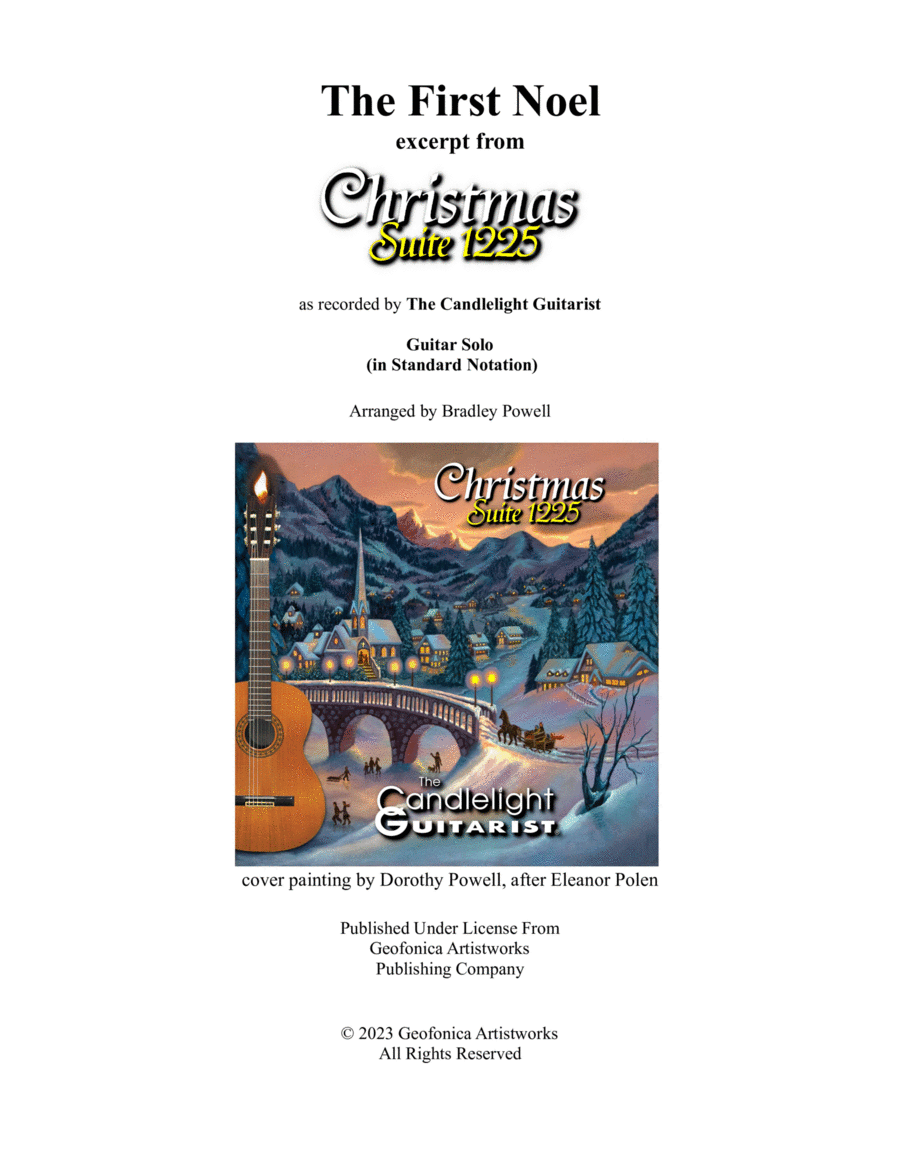Solo Guitar - Level 3 - Digital Download SKU: A0.1316202 By The Candlelight Guitarist. By Traditional. Arranged by Bradley Powell. Christmas,Classical,Holiday,Religious,Traditional. Individual part. 3 pages. Geofonica Artistworks #904939. Published by Geofonica Artistworks (A0.1316202). This arrangement of The First Noel is an excerpt from Christmas Suite 1225 (Part 1) - a new album by The Candlelight Guitarist (aka Bradley Powell). It features fingerstyle classical guitar, with a fresh chordal interpretation, moving bass and internal lines, and other distinctive stylistic features. The First Noel can be seen and heard in the Candlelight Guitarist YouTube video of Christmas Suite 1225 (Part 1) beginning at 3:02 (see timeline). The entire Christmas Suite 1225 is available for pruchase, including 14 traditional carols and one original piece.ABOUT: Brad Powell (aka The Candlelight Guitarist) began guitar at age ten, inspired by The Beatles. At 15, he became a protégé of jazz guitarist Joe Pass, and later studied classical guitar under Vincent Macaluso and at California State University, Northridge under Ronald Purcell, with a master class under Andrés Segovia. Brad was featured performing Gerald Wilson's Sonata for Guitar and Orchestra at the Hollywood Bowl, with the composer conducting. Brad was mentored in composition by David Rose (composer for Little House on the Prairie). Brad has composed music for TV, including Hill Street Blues and The 'A' Team, working with Mike Post. Brad has ten albums as The Candlelight Guitarist. When not making music, Brad is often out hiking with his four dogs. Brad has also played as the solo guitarist for Disney's Princess Breakfast Adventure at Disney's Grand Californian Resort by Disneyland (since its opening week), providing music for the Disney Princesses (Belle, Tiana, Jasmine, Rapunzel, Mulan, Aurora, Ariel, Pocahontas, Cinderella, and their friends and guests).COMMENTS FROM LONG-ESTABLISHED REVIEWERS (for this and other Candlelight Guitarist recordings)...Dr. Beth - Amazon.com #1 Hall of Fame reviewerBrad has a knack for putting together gentle, soothing guitar medleys which provide the perfect background or relaxation soundtrack.Bill Binkelman - Music Reviewer for Zone Music Reporter and New Age RetailerThe Candleight Guitarist is your tour guide to a land of easy-going, warm, and inviting instrumentals.Rebecca of Amazon - Amazon.com HALL OF FAME TOP 500 REVIEWERBradley Powell's flawless playing allows you to completely relax into sleep or relax into an evening of candlelight and romance. I've fallen into a peaceful sleep while listening to this music and have also spent relaxing afternoons reading while The Candlelight Guitarist wove an intricate tapestry of sounds to nurture my heart. ...  Bradley Powell's music is infused with natural ambience. As rich sounds renew your spirit, you can relax into a deep sigh of the heart. His style is artistic, heart healing and filled with romantic and cultural influences.Vicki Blizzard (Editor, PaperWorks and Crazy for Cross-Stitch! magazines) in CREATIVITY e-Letter: Music to filter into my dreams. My new favorite to listen to is classical guitar music by Bradley Powell.Bob McKillop, founder and publisher, MaineFolkMusic.comBrad Powell is a talented and highly trained California guitarist and composer who calls himself The Candlelight Guitarist, and for good reason. His music is perfect for situations in which candlelight figures prominently. Quiet meditation, romance, intellectual stimulation â the soft, pure tones of his Spanish and classic instrumental style open up your heart and render it more receptive to the spiritual messages that these pursuits engender..
